When comparing my image with Sank’s, I noticed that the biggest difference was the colours. I believe that colours are a huge part of the story for every photograph. It is obvious that both couples are of different cultures. When comparing my photo to Michelle Sank’s image, we can see that we chosen different environments. I think that our garden tells a big story and so I thought that each detail in both photographs are all very important and strong as there are objects which are treasured and have a lot of meaning.
All posts by Liana Dias
Filters
ESA // MY PHOTOGRAPHIC RESPONSE: SANK
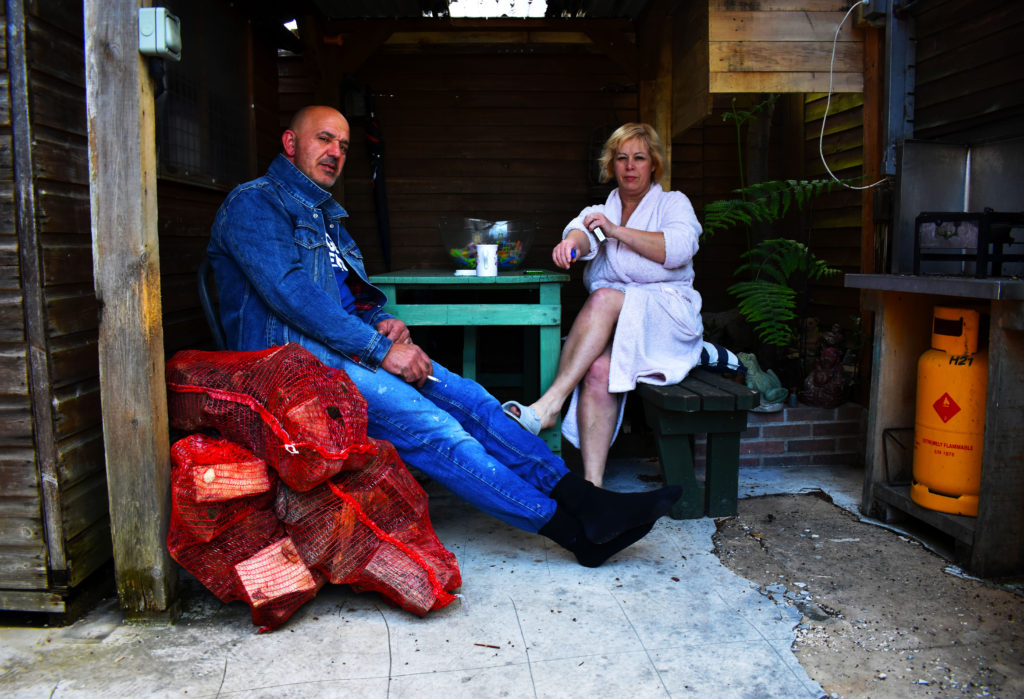
I took this photograph in response to Michelle Sank’s image of the two elderly figures. I decided that I was going to photograph my parents in a similar way, however, in a different area. An area where they both spend most of their time together. The garden was handmade, from the benches to the tables, the cooker, shelter, planting area and floor. This is another element that I really like about this image and I think that it is very powerful because it shows how things have become damaged and used. The wear and tear over the years has never been fixed and rarely nothing has refurnished. This is very important to me as it is the home that I grew up in, one which my father practically built.
The image was taken spontaneously and in my opinion, I think that it has made the image more powerful. I was arriving home with my camera as they were chatting away, they both stopped what they were doing and became distracted by the camera for a split second. The image was taken with a faster shutter speed and so it is all in clear focus. I wanted to make sure the photograph was all in focus as everything in the garden has it’s own story and builds up to my childhood. The red bags in the front of the image have wood inside them. I had just brought these bags home for my father to make us food on the grill outside while my mum used the cooker. This image made me realise that my father could potentially have built all these old fashioned styled things in order to bring our culture back into our home.

The colours in this image are very saturated and I did this to show the colour in our lives and the festive feeling of the portuguese culture. I also did this because I love the idea manipulating the colours in an image to give them a meaning. In this case, the brightst colours are red, green, blue, yellow, and white. All of these colours are in the Portuguese flag and therefore I though it would be a good idea to bring these colours out as much as possible.
I also noticed a similar pattern in Mahtab Hussain’s images and therefore wanted to ideas of my chosen photographers into one photograph.
ESA // RESPONDING TO: MICHELLE SANK

I chose this image because it was brought to my attention that Michelle Sank mainly photographs younger people in their bedrooms. Bedrooms full of posters and alternative colours, non of which are the same. The images were of more messy rooms and typically unique for every individual. I used this photograph as a visual inspiration because it was different from all the other images produced by Michelle Sank, I think it is a very powerful image with a lot of meaning behind it, from the colours, to the positioning of the subjects.
It shows an old couple sat the end of their bed in a very clean and tidy bedroom. They are also well dressed which may hint that they belong to the upper-middle class. There is a lot of daylight coming through the window behind and to the left of the camera creating a shadow on the other side of the bed. Overall, there are not too many shadows and the photograph is very bright with high exposures, as shown on the corner of the bed where only white can be seen.
Followed by a light tonal range and there is a lot of repetition in the colour range; beige, yellow and whites. This makes the photo very warm which could potentially reflect on the personality of these two elderly figures, expressing love and warmth. The image is unsaturated and consists of low contrasts. However, it still remains sharp, clear, and all small textures (i.e. the carpet) are enhanced. The photo also seems very empty, other than the very limiter furniture seen and the fluffy toy on the bed, there is not much story to the image. Of what is seen, we can say that this old couple live on their own and the emptiness in their room can also indicate sadness. Both figures are making subtle physical contact where they are both resting their hands on each other, showing affection and unity.
ESA // THE COMPARISON
In comparison, I think these images are very similar, especially in terms of meaning. They both show a man who lives in a different country to where they originate from. I think the image taken by Mahtab Hussain shows a young man who has changed in terms of dress style and lifestyle in order to fit in with the rest of the English community as there is a lot of hatred and racism, specifically aimed at Muslim men. In my image, we see an older man that continues to live his life as he did when he lived in his birth island, Madeira. Although both men are in different circumstances, I believe that where you originate from, there are various implications when it comes to racism and both culture are forced to commit to their new surroundings in order to live freely.
ESA // MY PHOTOGRAPHIC RESPONSE: HUSSAIN
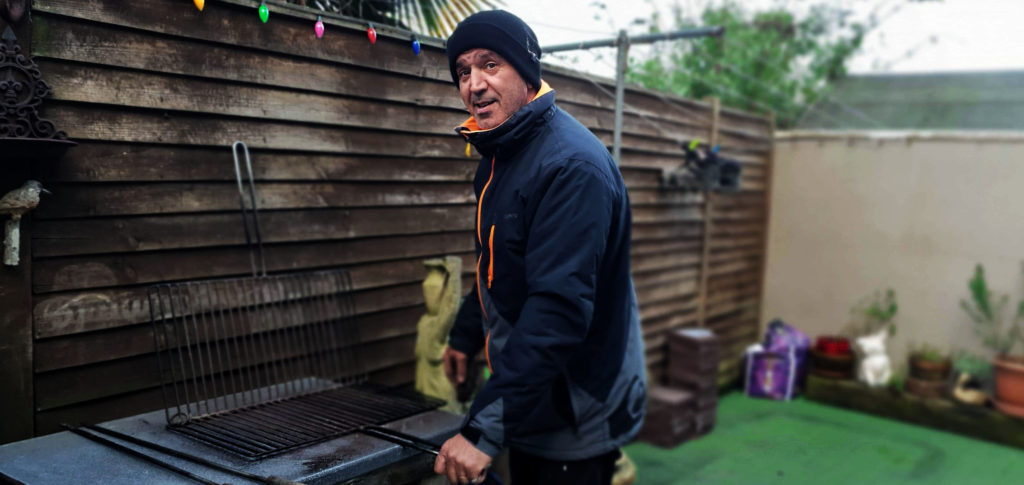
“Men build a house, women make it a home.”
In this image I was attempting to achieve the same contextual ideas as Mahtab Hussain; showing how different cultures live in different countries.
The image is slightly contrasted and brings out some facial features that show ageing; how the older generation live. The aperture used was set at f/4 which means the lens is wider, letting the sensor receive more light and a shallow depth of field. The low f-stop in general makes the background more blurry and makes the background obscure. The shutter speed was most likely around 1/60 as the image is typically quite bright and focused in the foreground which also enhances the textures of the fencing and old objects around him although the background is unfocused.
I captured this photo in natural day light on a cloudy day. The light looks as if it is coming from above and coming straight on as there are no intense shadows created by the man in the photo nor objects surrounding him. The subtle increase in saturation in this image highlights the colour of his clothing. I see a very high level of control of this photo. The man is positioned in the center and he is looking directly at the lens as if he was cleaning the grill and became distracted by the camera for a small glimpse. There are a range of tones from black (fence shadows) to white (highly exposed sky). The middle ground textures are very intensifying and really work as a visual effect. The mans eyes are the main focus in the image.
I took this photograph in my garden, a place that my dad built as my home and which has never been changed. I think this is a very important aspect of the image because it shows that men are typically the ones who build the house but women are the ones who make it a home. This is a strong way of thinking in my family. The older ways of living continue through generations and is an extremely common in the Portuguese culture. The wear and tear in the fence and statues show that this garden has not been refurbished for many years. I think everything in my garden has its own story and for as long as I can remember, my father has always worked for taking care of our family in heavy duty jobs; building and simply being the breadwinner for our family. This traditionally is not the case for many families nowadays, where domestic jobs are shared between a couple.
ESA // RESPONDING TO: MAHTAB HUSSAIN
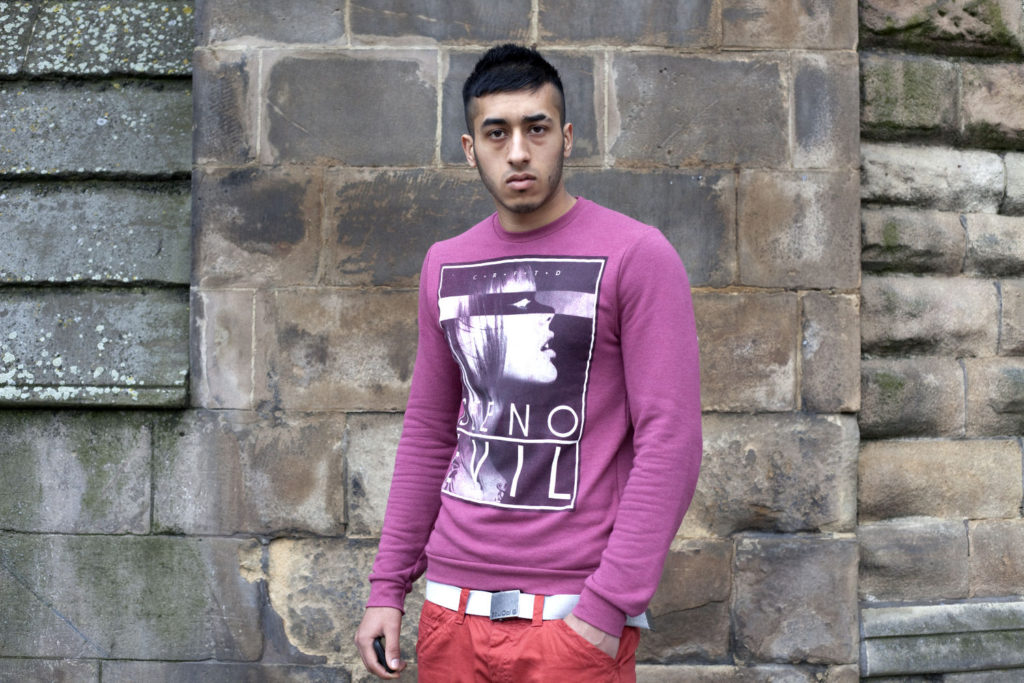
“I feel so invisible. That’s why I became an artist. I wanted to represent this society in artistic space.”
Mahtab Hussain
The reason I chose this image as it is one of my favourite from Hussain’s You Get Me? album and I think it is a very powerful image as the subject is engaging with the camera. I also decided that this would be one of the photos that I wanted to look into as I plan to achieve the same concepts as Mahtab Hussain and thought this would be the perfect starting point.
Hussain seems to have taken this photo in natural day light and the wall in the background supports the fact the photo is taken outside due to the condition that it is in. The light looks as if it is surrounding the whole area and coming straight on as there are no shadows created by the subjects figure however, the patterns in the walls are creating small shades below which reinforces the idea that the natural light is mainly strongest from above. The subtle increase in saturation in this image highlights the colour of his clothing as well as the wear and tear from the walls in the background and the image is not massively light sensitive as it is clear and focused. I see a very high level of control of this photo. The man is positioned in the center and he is looking directly at the lens although his body is slightly turned to the left.
The image is slightly contrasted and mainly enhances the natural shapes in the walls and signs of ware. The aperture used was most likely around f/32 which means the lens is smaller. A smaller aperture allows the middle ground and background to be in focus with the rest of the image. The shutter speed was most likely around 1/15 as the image is typically quite bright and focused, however, not over exposed. The slower shutter speed allows the camera to retrieve more light and makes it easier for contrasts to be seen. The textures are very intensifying and really work as a visual effect. There is a repetition of the same colours red and greenish mold which can be very meaningful in the photograph (see paragraph image No.2). The boys eyes are the main focus in the image as they are horizontally in the middle of the photograph leading the eye to his at first glance. Again, it could be argued that this is another method of manipulation as the viewer can feel more for the image as it tells a story.
Mahtab Hussain captured this image along with many other portraits. His idea behind these photographs was to show how people of his culture (Muslims) lived in a different country. In this case, London.

There is a lot of meaning behind this photograph. For example, in the image above, Hussain has saturated the colours which enhance green and red. These colours are most related to the Muslim culture, for instance, there are many different countries of where Muslims originate from. For example, the image above shows that the man in the image could potentially be representing the Bangladesh flag and how he lives in a foreign country.
ESA // INITIAL RESEARCH: PHILIP TOLEDANO
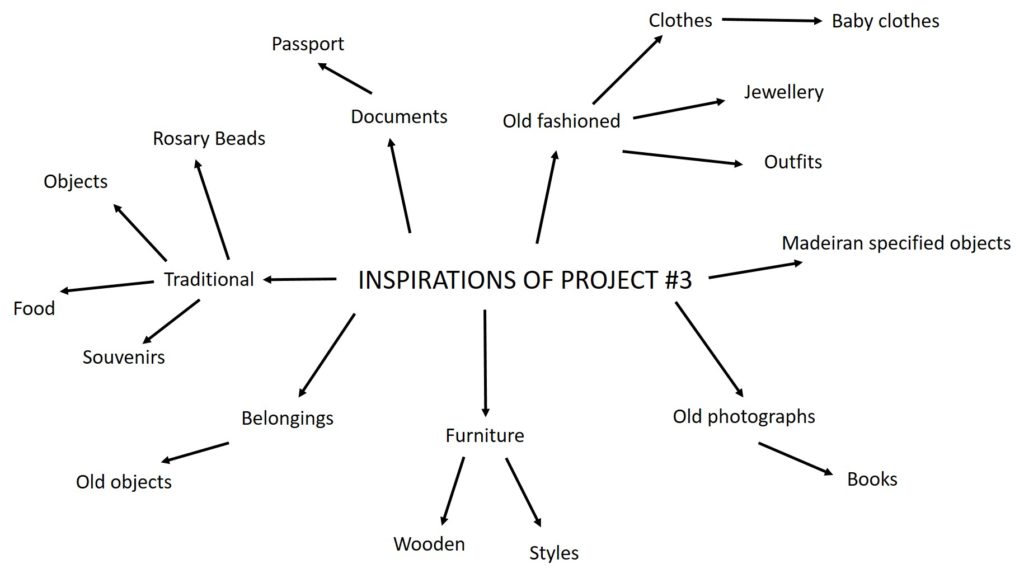
Toledano was born in 1968 in London, to a French Moroccan mother and an American father. He grew up in London and Casablanca. He received a BA in English literature from Tufts University in Boston. I consider Toledano s conceptual artist. His work varies in medium, ranging from photography to installation, sculpture, painting and video.
I think Toledano’s work is very interesting and I believe that these photographs are very powerful as they can tell so many stories. If you look at every photograph individually, each object obviously belongs to a person and they can all have a million meanings. When looking at the whole collection, the viewer can begin to put a story together and guess various situations.
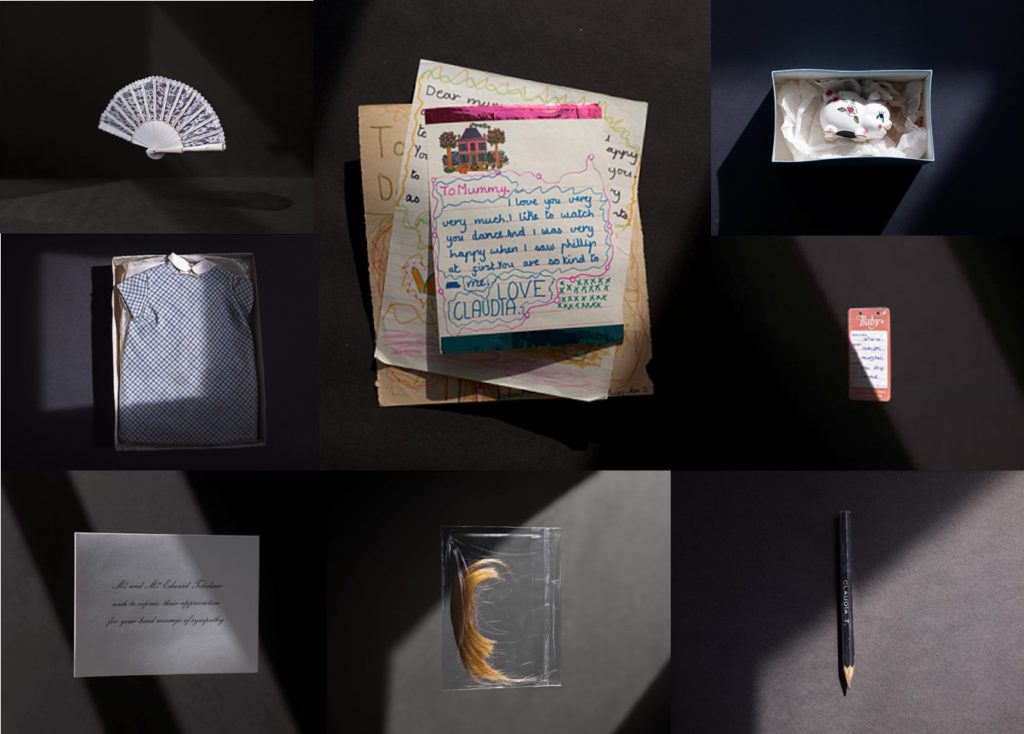
Again I have created a mood board using Toledano’s images. I am using these photographs as a visual plan for the sort of things I would like to photograph. For example, clothing, documents and other objects.
ESA // INITIAL RESEARCH: MICHELLE SANK
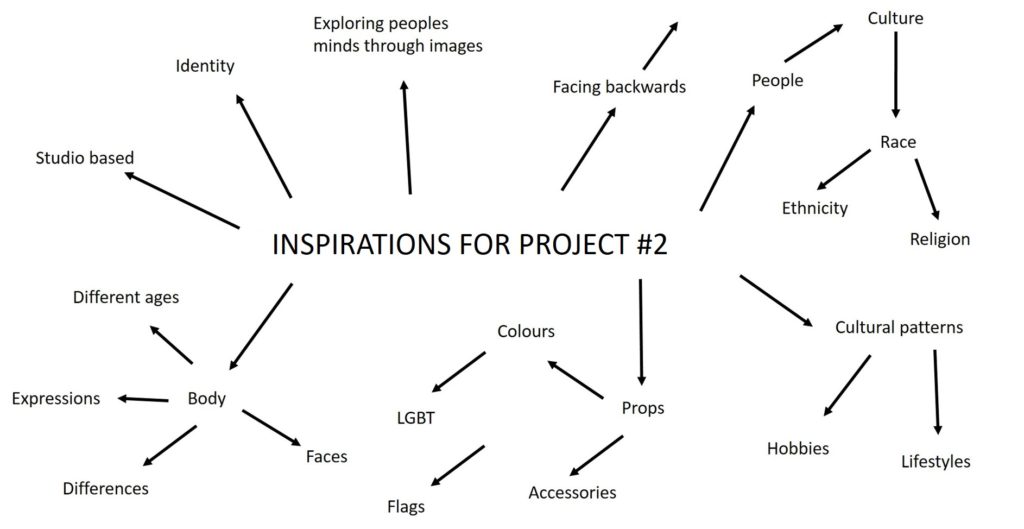
My other artist will be Michelle Sank. I enjoy looking at her work because she also focuses on portraiture, although she does not necessarily base her work on culture, but does photograph different people in different environments and i think these photographs tell stories about who these people are and show real personalities. I plan to use the same sort of approach of taking photographs of people in their everyday environments to show the real sides of people. I think the objects around these people are what bring her photographs together and really makes them interesting as there are always little things to look at.
Michelle Sankwas born in Cape Town, South Africa. She left there in 1978 and has been living in England since 1987. Her images reflect a preoccupation with the human condition and to this end can be viewed as social documentary. Her work encompasses issues around social and cultural diversity.
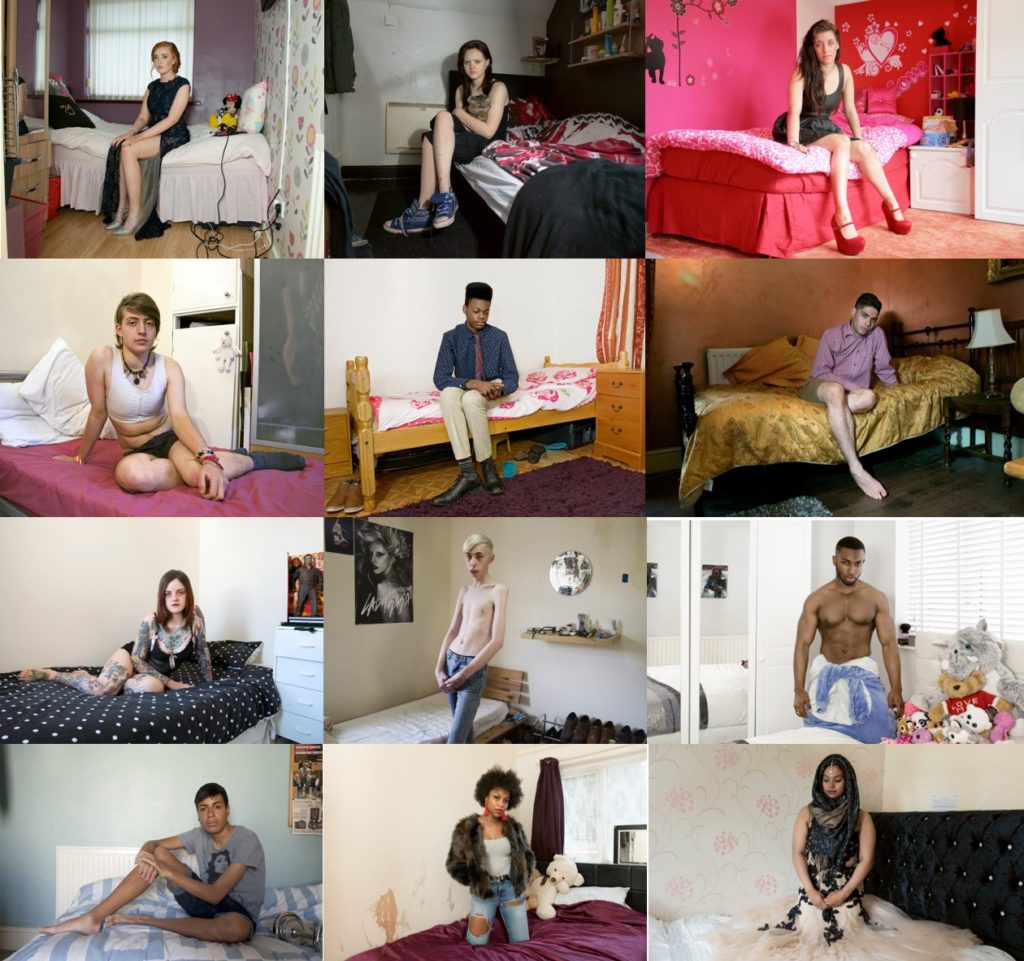
Above is a another mood board that I have created using Sank’s images. I plan to use these ideas to take photographs of people of different cultures in their everyday lives, using furniture and other props to enhance the idea of alternative lifestyles and personalities.
ESA // INITIAL RESEARCH: MAHTAB HUSSAIN
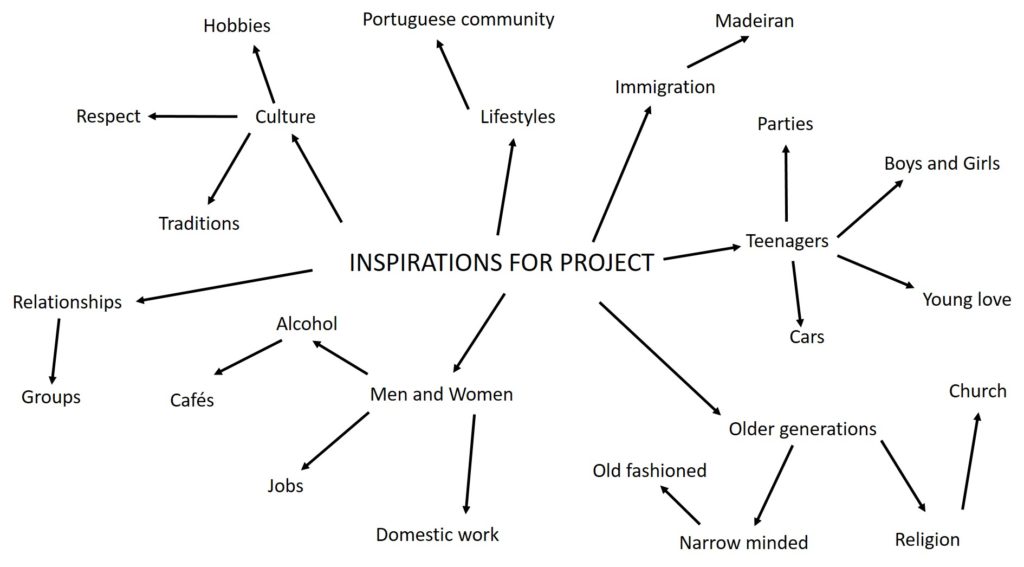
Above, is a mind map of my initial ideas. I have decided to go for a topic regarding displacement for immigrants and how different their day to day lives are. I plan to do this, mainly using portraiture. I specifically wish to explore the Portuguese community in Jersey, and enhance stereotypes. I will do this by capturing, lifestyles, cultures and traditions as a main objective. After researching photographers such as Mahtab Hussain, my interest for this project increased and it think his images are very powerful.
Mahtab Hussain is a British artist who captures images of his friends and family living their lives in a migrant country (in this case, London). These photographs show young Muslim men who no longer live in their native countries. Born in 1981, Hussain explores the important relationship between identity, heritage and displacement. His themes develop through long-term research articulating a visual language that challenges the prevailing concepts of multiculturalism. Hussian has publish 4 artist books. He specialised in Fine Art Photography in Goldsmith College and achieved an MA in Museum and Gallery Management, City University.
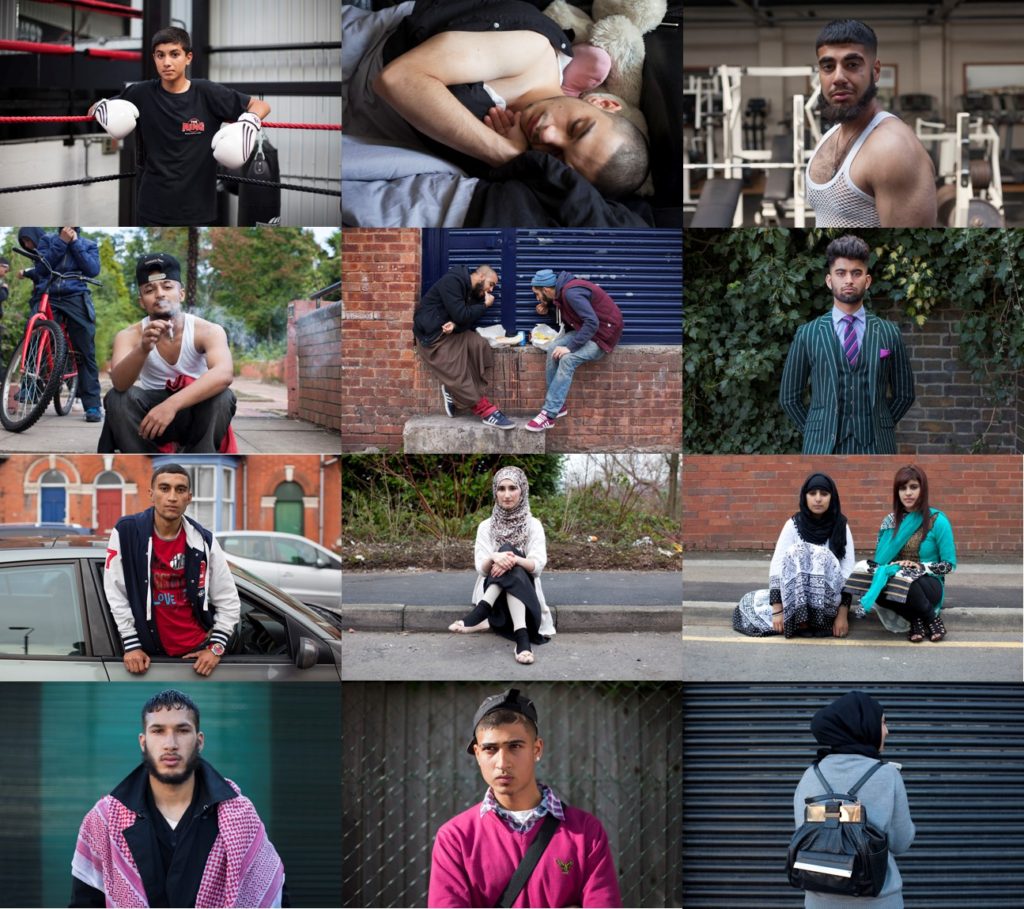
Above is a mood board that I have created using Hussain’s images. I am using this photographer as a visual inspiration for my cultural photography plan. These photographs attracted my attention as most people are engaging with the camera and I think this give the images more context. My plan is to respond to this artist and explore this type of photography to a deeper level.
ESA // SPECIFICATION
After researching different photographers, the photographer who most caught my attention was Mahtab Hussain. This photographer looks at his cultural background and how people live nowadays. I have chosen to follow this photographer for this project because the life that Portuguese people live, really interests me. I decided to do this and plan to take photos of my day to day life, to show how youngsters live in a different country. I thought this would be the ideal project to look into because there are so many immigrants in Jersey which originate from Portuguese speaking countries, mainly Madeira.
In my images I aim to show how gender affects different lifestyles in the Portuguese community. I also believe that these ideas affects the younger generation due to the respect insisted by older family. I find this very interesting as I believe that males tend to live a free life, whereas females tend to stay home with their mothers. Portuguese men traditionally go for heavy duty jobs, mainly in construction and women work more in domestics. I aim to focus on family, relationships, home life and religion/tradition.
Living within a Portuguese family allows me to explore these details with more depth and explore the variations and similarities within different cultures. I will be doing this by shooting specific hours and days in my day to day life that I believe strongly represent other Portuguese families and immigration from Portuguese to English speaking countries. Stereotyping plays a huge role in this project, not all migrant Portuguese families live the same way however, I believe that there is a stronger relationship to this with Madeiran families rather than main land Portugal. I think this is the case as Portugal tends to be more advanced and people tend to be more accepting of the new ways of thinking, on the other hand, Madeiran families can be narrow minded and insist a lot of respect with the older ways of thinking. With this project, I want to show how important religion is to most Portuguese families, along with family traditions and the difference in lifestyles from males and females, both old and young.
When doing my research I decided that my main subject in all photographs was going to be people. I have always had an interest in portraits and exploring different types through my camera. A lot of my personal work also includes facial features, from humans and animals too. Silence says more than a speech and actions speak louder than words and I enjoy the fact that photographs are silent moments, and silent moments are usually used to appreciate situations.
My love for silence has sprung from my experiences in photography where I have been able to understand people from a deeper perspective and after living difficult situations in life I always explore peoples facial expressions, and focus on the eyes. Whilst also exploring the life of an immigrant through portraiture, I also plan to capture images of objects, possibly handmade/traditional. I rarely photograph objects but I think it could be really strong used as a pause between the images.
